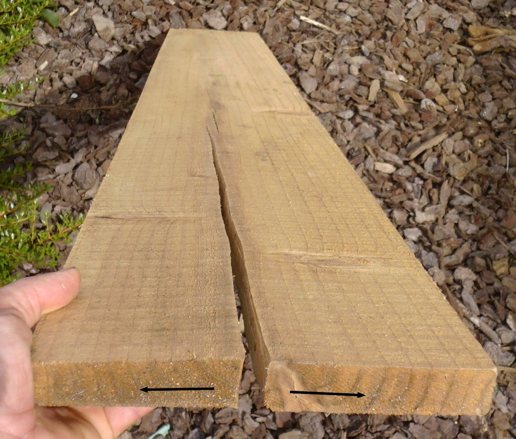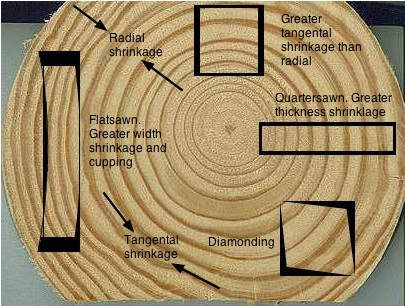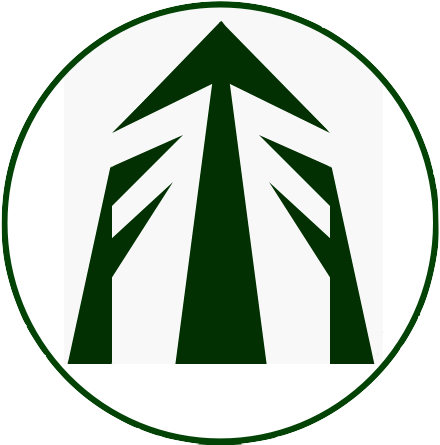Sawmilling Softwoods - The Issues

"Softwoods" are sometimes called needle-leaved trees, conifers or gymnosperms. These include cypress, macrocarpa, redwood, cedar, totara, rimu and kauri.
Sawmilling of Softwoods
Softwoods are considered easier to saw than hardwoods because they are generally faster cutting and require fewer saw sharpenings. Also the sawing techniques generally do not need to consider board movement off the log (i.e. resulting crook and bow
and bow ) and thus are faster and easier.
) and thus are faster and easier.
Shrinkage and drying
Drying of softwoods is generally fairly straight forward and shrinkage
Tangental shrinkage is greater than radial is fairly low. Wide boards can be cut without the level of degrade from cupping that is prevalent with drying wide hardwood boards. The sawing orientation of the board (i.e. from flatsawn to quartersawn) is not an important factor in seasoned product degrade. However orientation does affect figure and grain patterns, a consideration when marketing the resulting timber.
that is prevalent with drying wide hardwood boards. The sawing orientation of the board (i.e. from flatsawn to quartersawn) is not an important factor in seasoned product degrade. However orientation does affect figure and grain patterns, a consideration when marketing the resulting timber.
Softwood is usually cut green to nominal (or "call") sizes.
| Call sizes (mm) | 25 | 40 | 50 | 75 | 100 | 125 | 150 | 200 | 225 | 250 | 300 |
| Actual dressed dry size (mm) | 19 | 35 | 45 | 70 | 90 | 115 | 140 | 180 | 205 | 230 | 280 |
Movement in service
Movement in service is fairly low for most softwoods. Quartersawn material does tend to be more stable but the additional level of stability offered is not usually a consideration when specifying product. Boards containing pith are inevitably the most unstable, followed by wide flatsawn boards.
Portable sawmilling technology
Multi-blade (dimension sawmills) and swing-blade circular sawmills can be inexpensive and productive portable sawmills. Bandsaws, however, because of their thin kerf are able to convert up to 20% more of the log into lumber than circular saws. Swing-blade sawmills (e.g. Lucas, Peterson) cannot cut wide boards or large dimension stock and Multi-blade sawmills (e.g. Mahoe, Rimu) cannot cut wide (bark to bark) slabs from logs. Portable bandsaws such as the Woodmizer are very versatile and can cut everything from large beams to wide slabs with very little waste due to the thin-kerf band. Portable swingblades and dimension mills are good for milling large logs into standard sized boards and without having to move them.
There are many sawing options to convert logs into lumber and it is advised to talk with suppliers about what options are appropriate.
Sawing softwoods with a Woodmizer»
The species
Cypress
Lawsons and Leyland cypress should have the sap and heart segregated when fresh as its harder to differentiate heart and sap in the seasoned state. Lawsons cypress has a fairly wide sap band.
Macrocarpa and lusitanica
Macrocarpa and lusitanica have few problems with sawing.
Farm-totara
Farm-totara can have tension in the logs and sawing should aim for straight boards.
Redwood
Redwood has a large sap band and sawing patterns, if targeting heart, should aim to segregate the more valuable heart from the sap. Paper wasps can chew the wood as its seasoning
Cedar
Western red cedar is prone to collapse and internal checking as it dries. Always saw to the final dimension as the option of ripping seasoned larger stock into smaller boards will result in extensive surface checking on the ripped face. Western red cedar should also be sawn oversized to allow for the high shrinkages and collapse. If possible it should be quartersawn.
Paper wasps can chew the wood as its seasoning.
Disclaimer: While every effort is made to ensure the accuracy of the information provided on this site, Farm Forestry Timbers Society do not accept liability for any consequences arising from reliance on the information published. If readers have any doubts about acting on any articles they should seek confirming, professional advice.
 Farm Forestry New Zealand
Farm Forestry New Zealand Farm Forestry Timbers - Headlines
Farm Forestry Timbers - Headlines